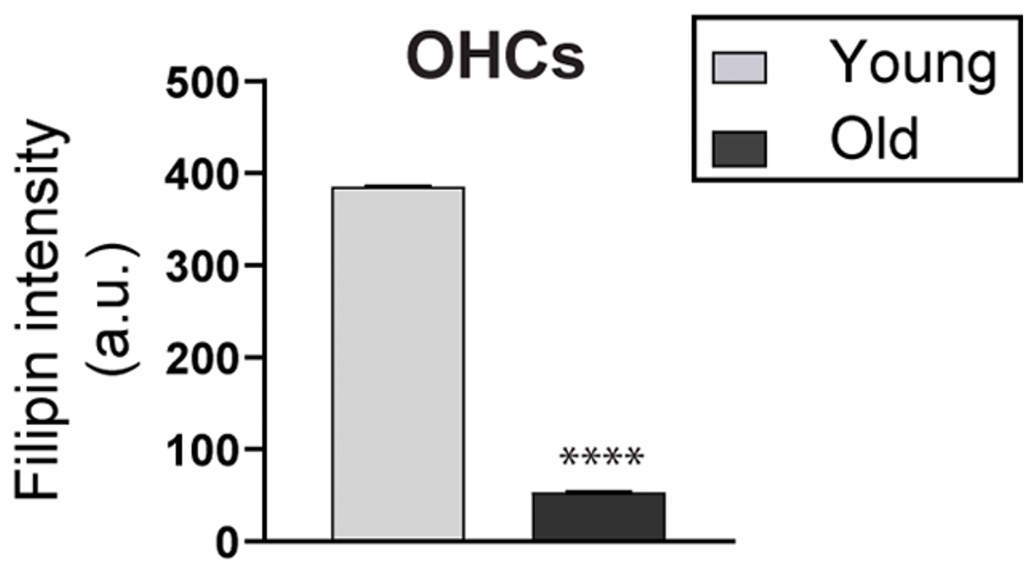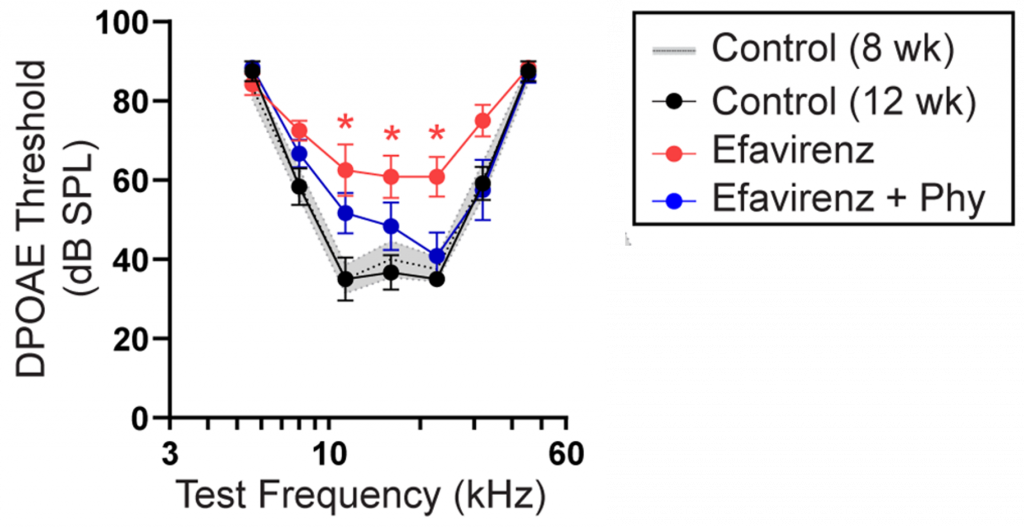Key Points:
- Old mice exhibit diminished cholesterol in their inner ear’s sound-detecting cells (outer hair cells).
- Phytosterols partially restore cholesterol and prevent hearing loss.
- A critical protein needed for outer hair cells to properly detect sound is also partially restored by phytosterols.
Hearing loss is strongly associated with cognitive decline and dementia in older adults, hinting that a general collapse of brain function accompanies deficits in its sensory architecture. Our hearing ability depends on sensory cells within our inner ear that change in length in response to sound, which surprisingly could be affected by cholesterol levels in the brain.
Indeed, Sodero and colleagues from the University of Buenos Aires and the National University of Cordoba in Argentina report in PLOS Biology that cholesterol levels are low in the ear sensory cells of old mice. Accordingly, they generated a hearing loss mouse model that recapitulates this low cholesterol. They then showed that hearing loss could be prevented by treatment with cholesterol-boosting phytosterols.
“Our findings are very promising because they provide the first proof-of-principle supporting phytosterols supplementation as a possible approach for prevention or treatment of hearing loss,” said the authors.
Phytosterols Prevent Hearing Loss
Reduced cholesterol has been observed in the brains of aged individuals and those with neurodegenerative diseases. Furthermore, restoring brain cholesterol in aged mice reverses their cognitive deficits. To confirm some of these findings, Sodero and colleagues measured the cholesterol levels from the nervous system’s sensory machinery within the ear of aged mice.
To do so, the researchers measured a protein called filipin from sensory cells within the ear called outer hair cells (OHCs). Mouse and human OHCs change length in response to vibrations from soundwaves, allowing for hearing. It was found that compared to young mice (2-months-old), old mice (24-months-old) had far less filipin, suggesting that old mice have less cholesterol in their OHCs.

To model the reduced OHC cholesterol observed in aged mice, Sodero and colleagues exposed young mice to an anti-HIV medication called efavirenz. Efavirenz is known to stimulate an enzyme that removes cholesterol from the brain. Young mice were chosen for this model due to their superior hearing sensitivity, making it easier to measure their ability to hear.
The researchers found that the hearing threshold of efavirenz-exposed mice was 20- to 30 decibels higher than normal mice, indicating OHC dysfunction and hearing loss. However, significant hearing loss was not observed in efavirenz-exposed mice treated with phytosterols. These findings suggest that phytosterols prevent hearing loss caused by OHC dysfunction.

To determine if efavirenz-exposed mice have reduced OHC cholesterol levels that could be restored by phytosterols, Sodero and colleagues again measured filipin levels. As expected, efavirenz-exposed mice exhibited reduced OHC cholesterol levels. Furthermore, phytosterol treatment partially prevented this reduction in cholesterol levels.
To clarify how cholesterol could be restoring OHC function, the researchers measured a protein called prestin. Prestin is essential for the changes in length OHCs make to allow for hearing. The results showed that efavirenz-exposed mice exhibited reduced prestin in their OHCs. Moreover, phytosterol treatment partially restored OHC prestin levels, suggesting improvements in OHC sound-detecting function.

Altogether, the findings of Sodero colleagues suggest that low OHC cholesterol levels perturb prestin levels, leading to OHC dysfunction and hearing loss. This can be explained by the structure of OHCs. The membranes of our cells, including OHCs contain cholesterol, which maintains the structure of our cell membranes. Thus, prestin, which is found in OHC membranes, is influenced by cholesterol.
It follows that cholesterol and prestin loss could interfere with the length-changing function of OHCs, which can be restored by phytosterol supplementation. Since OHCs need to shorten and elongate for us to properly detect sound, and intact prestin levels are required to do so, phytosterols seem to restore hearing by reconstituting the structure of OHCs.
Phytosterols Elevate Brain Cholesterol but Lower Blood Cholesterol
Sodero and colleagues conclude, “In the present work we show that: 1) aging triggers cholesterol loss from sensory cells of the inner ear, 2) a retroviral treatment widely employed for HIV/AIDS patients reproduces the cholesterol loss observed in aged individuals and leads to impaired outer hair cells’ function and 3) we found that these defects can be partly reversed by phytosterols supplementation.”
Considering that cholesterol has been demonized for many years, some may be wondering how increasing cholesterol levels in the brain could be good. Interestingly, the cholesterol circulating in our blood cannot pass the blood-brain barrier and therefore cannot enter the brain. Because of this, our brain regulates its own levels of cholesterol. However, phytosterols have the capacity to pass the blood-brain barrier, which may explain how they can alter brain cholesterol levels.
Perhaps more interesting, phytosterols have been shown in many studies to lower blood cholesterol levels in humans. One analysis of 41 human trials found that 2 grams of phytosterols per day can result in a 10% reduction in “bad” LDL cholesterol, whereas higher doses provide only a small additional benefit. Such a dose can be purchased online for as low as about 25 cents.